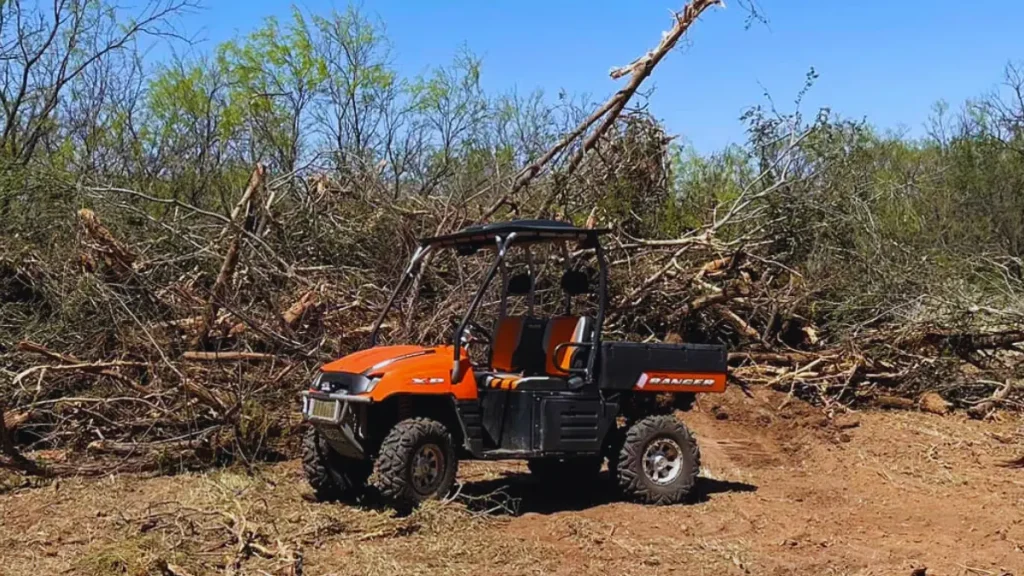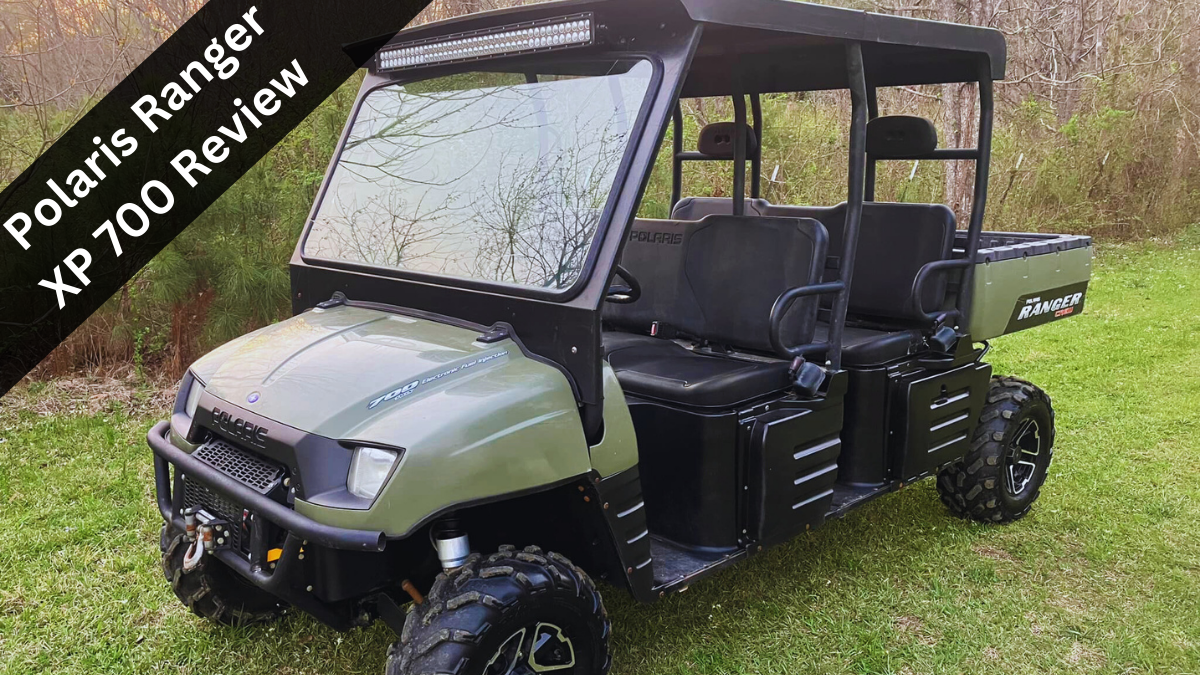If you wanted one of the sturdiest and most reliable utility-focused side-by-sides back in the mid-2000’s, chances are you were giving the Polaris Ranger XP 700 a look.
Not only were these models some of the better workhorses around back then, but they also offered impressive recreational ability for the time with good trail riding ability and a decent top-end speed.
While Polaris has grown and upgraded their line of Rangers since then, a used Ranger XP 700 in good shape still makes for one of the best used side by sides you can find for under $5,000.
But there are both some strengths and weaknesses to consider before purchasing one, which will be detailed in this guide along with:
- Build quality and performance
- Design and durability
- Top speed
- The Ranger 700’s main strengths
- The Ranger 700’s main weaknesses
- What to look out for in used models
About The Polaris Ranger XP 700
The Ranger XP 700, also referred to as simply the Ranger 700, is a utility-focused side-by-side manufactured by Polaris from 2005 to 2009 that was sold alongside Polaris’ best sport side-by-side of the 2000’s in the RZR 800.
The Ranger 700 was made in both a two-seater and a crew model, with the latter making for one of the best four seater UTVs of its time.
During the years of its production run, it was popular among outdoor enthusiasts and working folks due to its impressive versatility.
Whether performing the toughest of working tasks around the property or trail riding through rugged terrain, the Ranger 700 would get you where you needed to go.

Though it performed well off-road, this model’s reputation was one of a straight workhorse that could tow or haul heavy loads across rough terrain without losing a step.
It looked every part of a hard worker too, with a body styling that was rugged and not flashy – though the last production model in 2009 was upgraded to a more modern body style.
And while it was known for being durable and holding up well to abuse, there were/are some recurring issues among some components of this model.
Build Quality & Performance
Engine
Though not one of Polaris’ newer ProStar engines like those used in the new Polaris Ranger 1500, the engine in the Ranger 700 is about as solid as they come and will rarely give you trouble as long as you service it as regularly.
This 4-stroke, liquid-cooled, V-Twin engine has a displacement of 683 cc and gets a power output of around 40 HP.
This gives it plenty of oomph to power through rough terrain like mountain trails, mud, shallow water, and ruts.
EFI ensures efficient fuel delivery, though it’s susceptible to low fuel pressure which can lead to the fuel pumps going out more than they should.
Additionally, the engine’s location is more central in these models, which can cause the seats in the Ranger 700 to warm to an uncomfortable level from the heat the engine puts since it is in closer proximity to them.
The engine has been moved back in most new UTVs to combat this and make for better stability.
Aside from the location, the only real drawback you’ll find with the engine itself is that it is pretty loud, making it tough to hear your passenger(s) while riding, especially in 2005 – 2007 models.
| Engine Type | Four Stroke |
| Cylinder Arrangement | V-Twin |
| Displacement | 683 cc |
| Horsepower | 40 HP |
| Fuel System | EFI |
| Engine Cooling | Liquid Cooling |
| Fuel Capacity | 9 Gallons |
Suspension
Up until 2009, Ranger 700 models were equipped with a MacPherson Style strut suspension up front and Dual A-Arms in the rear.
The suspension system is fine for the intended use of the machine, but MacPherson struts tend to lead to a rougher ride in rough terrain.
In 2009, the front suspension got an upgrade to Dual A-Arms as well, making these models the best off-road and trail vehicles among the different production years.
Suspension travel is between 9 and 10 inches up front and 9 inches in the rear depending upon the model, which is good for an older machine and helps to soak up bumps well.
And with a solid ground clearance of between 11 to 12 inches, you can ride rutted trails and right over top of most obstacles without fear of bottoming the Ranger 700 out.
| Turning Radius | 12-13 ft |
| Wheelbase | 76 in |
| Max Ground Clearance | 11-12 in |
| Front Suspension | Macpherson Strut (Dual A-Arm for 2009) |
| Rear Suspension | Independent Dual A-Arm |
| Front Travel | 9-10 in |
| Rear Travel | 9 in |
Drivetrain
The Ranger 700 features an On-Demand true AWD/2WD system, giving it added traction for trails and other rough terrain.
The automatic PVT transmission makes for smooth, quick gear shifts. But some of these models do have a tendency to suffer from the dreaded Polaris Ranger clutch problem.
These models do not offer a Park setting, so you’ll need to use the hand-operated parking brake to keep them from rolling when stopped.
There is both a Low and High gear, along with Neutral and Reverse.
| Drive System | On-Demand True 4WD/2WD |
| Transmission Type | Automatic PVT |
| Gear Shift Pattern | H – L – N – R |
Tires & Brakes
Stock tires on all models were 26-inch PXT Radials in the front and rear.
These tires provided sufficient grip and stability for both working tasks and off-road riding, though terrain like steep, sandy creek banks would cause them to lose traction.
Many newer models have been outfitted with bigger, upgraded tires which perform a little better out on the trail.
There are four-wheel hydraulic disc brakes which are plenty-capable of stopping this vehicle quickly, along with a hand-activated mechanical parking brake for use when stopped.
| Front Tires | 26 x 8-12 PXT Radial |
| Rear Tires | 26 x 11-12 PXT Radial |
| Front Brake Type | Hydraulic Disc |
| Rear Brake Type | Hydraulic Disc |
Dimensions
The Ranger 700 is a big, bulky model compared with some of today’s UTVs in a similar class.
But its size contributed to its ability as a workhorse and its bulky, tough outer builds is one reason many of these models have held up so well to the abuses of working and off-road riding through the years.
While they perform well on the trails, they’re nowhere near as nimble as many more modern utility-focused models.
And at 60 inches in width, they’re limited to wider trails and not the best choice for snaking through tight wooded areas.
But at somewhere around 1,200 lbs by model, these beastly machines offer a solid towing capacity of 2,000 lbs and hauling capacity of 1,000 lbs via the rear cargo bed.
| Length | 114 in |
| Width | 60 in |
| Height | 76 in |
| Dry Weight | 1,185 – 1,237 lbs |
| Towing Capacity | 2,000 lbs |
| Cargo Box Capacity | 1,000 lbs |
Polaris Ranger 700 XP Top Speed
A used Ranger 700 XP in good condition should be able to hit a top speed of right around 50 mph, which is not all that slower than some of today’s fastest Polaris Rangers.
There’s a rev limiter in place that will limit the top speed to 50 mph, and you’ll notice the RPMs fall off in that range.
Some used models will only be able to reach into the mid-40 mph ranges due to some flaws that affect their engine outputs and speed.
If your Ranger 700 won’t top 48-50 mph, you may have a throttle position sensor (TPS) out of adjustment or a fuel pump going south, which are common issues that affect the speed.

Strengths Of The Polaris Ranger XP 700
- The engines used in the Ranger 700 models are pretty bulletproof and are known for being higher quality than those used in later Ranger models that followed like the Ranger 800.
- The transmissions in these vehicles are also known to be almost bulletproof, lasting longer and seeing less issues than Polaris transmissions that followed in the years just past 2009.
- The overall performance these provide, especially from a utility perspective, are hard to beat – you can do serious work in these models.
- These models were made back when there were less shortcuts taken in terms of the quality of parts and components they’re made with, so they’re more durable than some models that followed shortly after.
- Excellent towing and hauling capacities, with a large rear cargo bed.
- Cab area is plenty spacious, with even crew models offering plenty of legroom and not cramming riders shoulder to shoulder.
Weaknesses Of The Polaris Ranger XP 700
- The engine is located more centrally in these models than in the rear like with current models, which leads to excessive heat from the engine warming the underside of the seats to an uncomfortable degree on warm days.
- The engine is louder than most modern-day Ranger models, making it tough to hear passengers while accelerating.
- The stock ECM in pre-2007 units is known to provide less voltage than it should but also to supply voltage when the machine is not in use which leads to the battery dying repeatedly.
- The connectors/fuses to the pre-2007 models’ ECM are known to melt or burn occasionally from overload or shorting, ruining the ECM.
- These models are quite prone to EFI issues from low fuel pressure, which leads to a number of needed fuel pump replacements.
- The sensor wires in the Ranger 700 (TBAP/TPS/CPS) are prone to rubbing on the engine and going bad, leading to the need to replace wiring harnesses often.
- The throttle position sensor in these models is known to go out of adjustment, which will negatively affect the power and speed.
- Need to apply constant pressure to the accelerator and brake going downhill as the factory clutch will sometimes cause it to free roll if not.
Some of these drawbacks are similar to common problems found in the Polaris Ranger 1000 and issues with the Polaris Ranger XP 900.
Final Thoughts
While most Ranger 700 models are getting up there in age, there’s a reason they’re still looked at as one of the best used UTVs you can buy for the money these days.
You’ll want to inspect used models to see if they exhibit any of the issues listed above or if they’ve had modifications done to shore some of these up, but for the most part you can’t go wrong with a Polaris Ranger 700.


